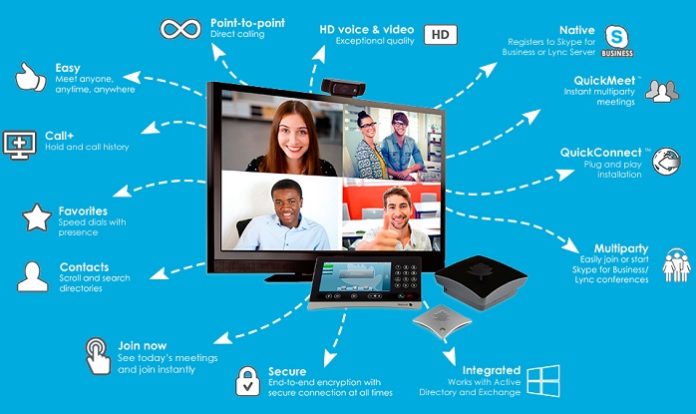Videotelephony, sometimes also referred to as video teleconference or videoconferencing, comprises the technologies for the reception and transmission of audio–video signals by users in different locations, for communication between people in real time. A videophone is a telephone with a video display, capable of simultaneous video and audio for communication between people in real time.
Videotelephony implies the use of this technology for a group or organizational meeting rather than for individuals, in a videoconference. Telepresence may refer either to a high-quality video-telephony system (where the goal is to create the illusion that remote participants are in the same room) or to meet-up technology, which goes beyond video into robotics (such as moving around the room or physically manipulating objects). Videoconferencing has also been called “visual collaboration” and is a type of groupware.
While development of videoconferencing started in the late 19th century, the technology only became available to the public starting in the 1930s. These early demonstrations were install at “booths” in post offices and showing at various world expositions. It took until 1970 for AT&T to launch the first true videoconferencing system, wherein anyone could subscribe to the service and have the technology in their home or office. Videotelephony also included “image phones” which would exchange still images between units every few seconds over conventional plain old telephone service (POTS) lines, essentially the same as slow-scan TV.
The development of advanced video codecs, more powerful CPUs, and high-bandwidth Internet telecommunication services in the late 1990s allowed videophones to provide high quality low-cost color service between users almost any place in the world where the Internet is available.
Which technology is used in video call?
Network for data transfer – today most video conferencing is transmit over a high-speed broadband Internet connection, using similar technology as VoIP (Voice over Internet Protocol) but LAN and occasionally ISDN connections are use.
How does video call technology work?
Videotelephony allows people at two or more locations to see and hear each other at the same time, using computer and communications technology. They exchange visual information with Webcams (digital video cameras) and streaming video. Audio content may distributed via computer or the telephone system.
What is needed for video calling?
Microphones and cameras: built-in microphones and webcams, USB microphones and webcams. Speakers: built-in computer speaker, external speaker, VoIP (voice over IP) conferencing phone. Internet Connection: WiFi, ethernet. Video Conferencing Software: video conferencing tools and apps.
How do I set up video conferencing?
- Send a meeting invite with an embedded video link.
- Click on the link when it’s time for your virtual meeting.
- Join the conference call, share your screen and enjoy the benefit of face-to-face communication.
What is the purpose of videophone?
A video phone is a device that assists Deaf and hard-of-hearing people who use sign language in communicating with others. The phones can used by Deaf people to communicate with each other over the phone, or with hearing people through a sign language interpreter.
Where should the camera be placed in a video conferencing meeting?
- If possible, position the camera at eye level, which provides the most natural orientation for face-to-face collaboration.
- The video performance may diminished if the camera is positioning too high or too low relative to meeting participants.
Is video conferencing hard to use?
But the reality of video conferencing is a mix of confusing software, subpar hardware and the awkwardness of still-developing social norms. For people thrust into the work-from-home life for the first time. Learning how to act on video conferences can be as much of a struggle as figuring out how to dial in.
What is the two-way videophone?
Zara demonstrating his latest invention: a two-way television telephone. And videophone, patented as a “photo phone signal separator network.” Zara, a physicist, invented a device that makes it possible. For two persons to see each other on a television while talking on the telephone as early as 1954.
What are the do’s and don’ts of video conferencing?
- Be organize and on-time for the meeting.
- Test your technology.
- Mute yourself when not speaking.
- Minimize distractions.
- Professional Look.
- Camera Positioning and Lighting.
- Visuals for participation enhancement.
- Pay Attention.





